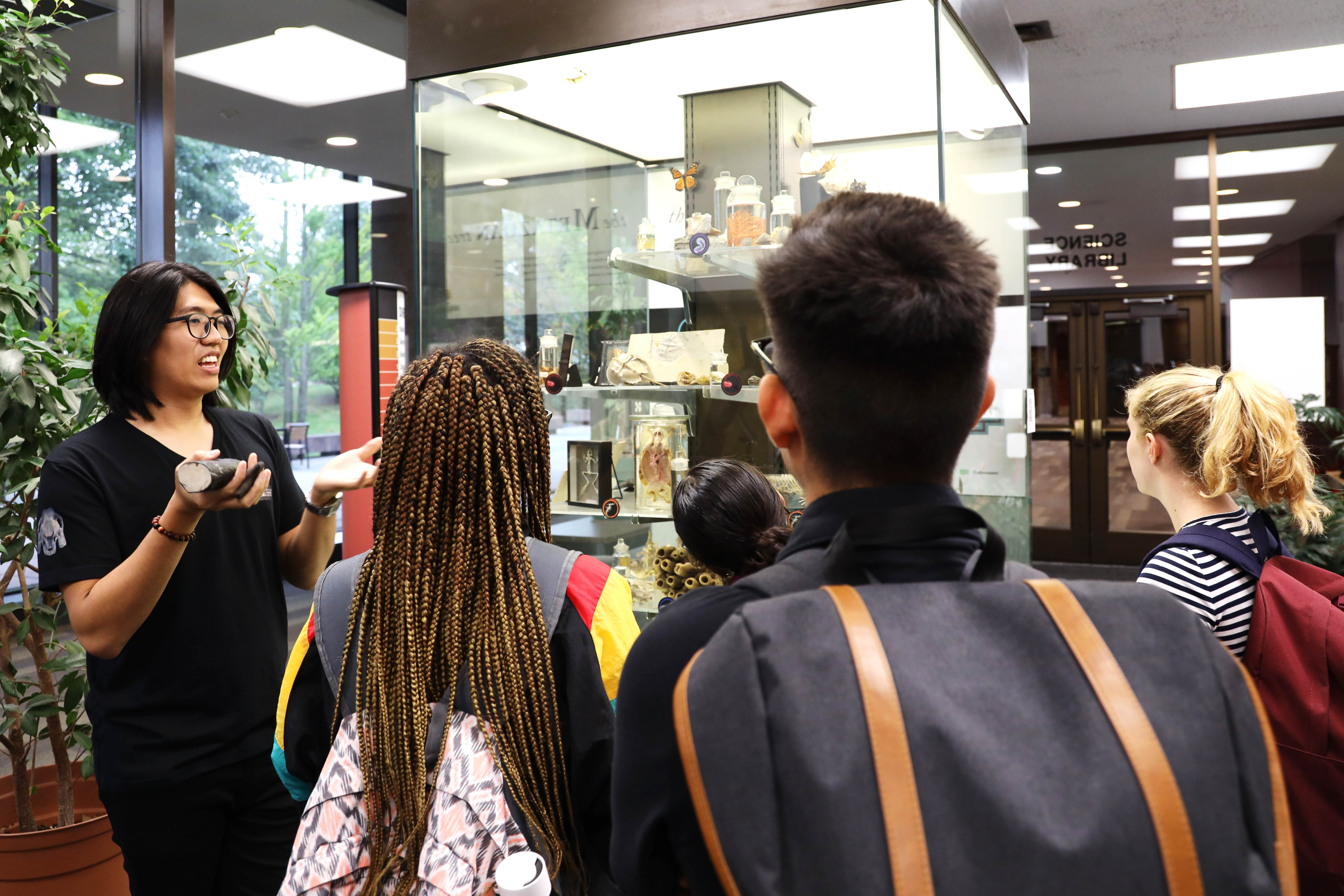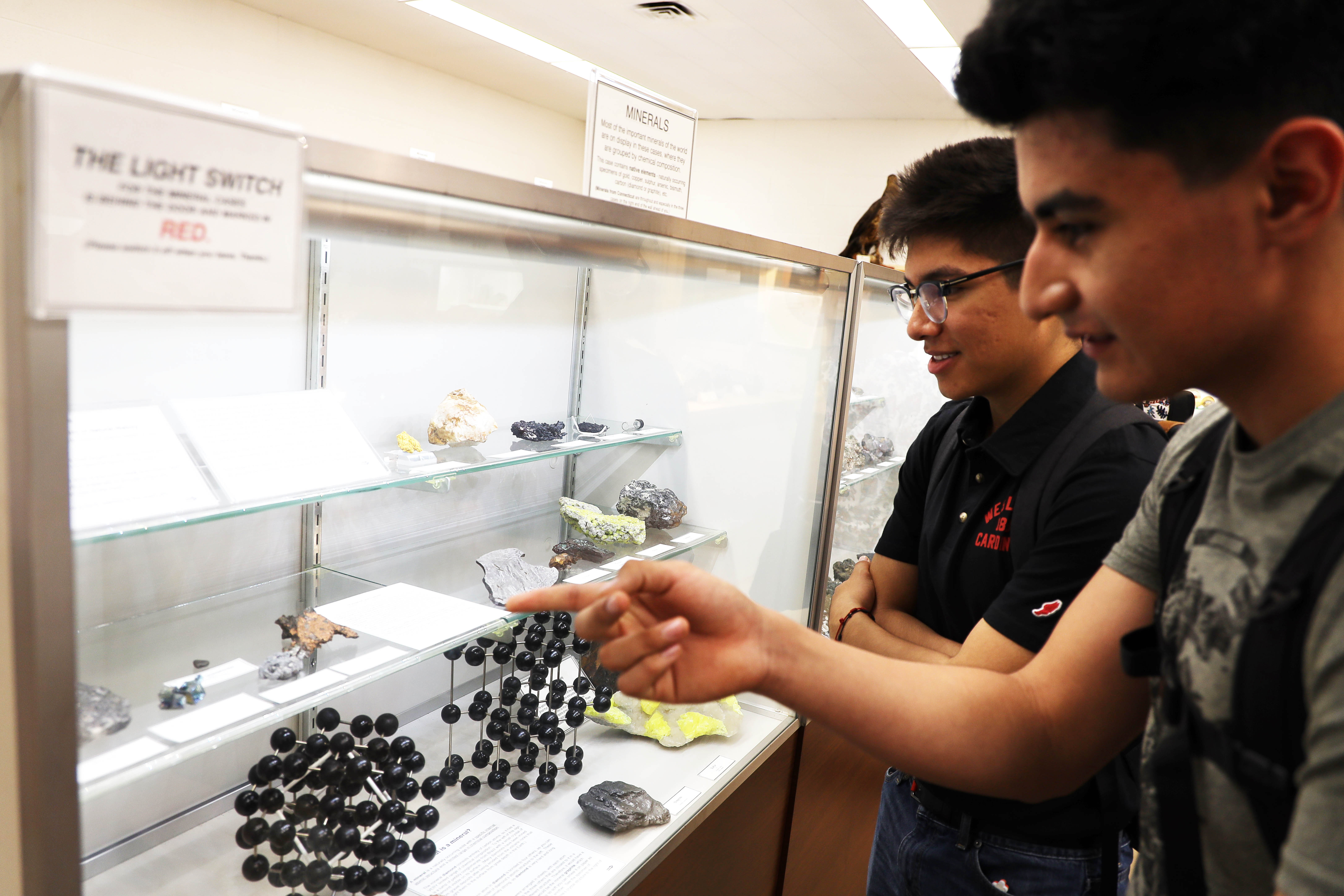
Student curators at the Joe Webb Peoples Museum of Natural History gave tours of museum collections last week in conjunction with the ongoing efforts to revitalize the University’s natural history museum. The tours took students through displays in the Exley Science Library, the Shanklin second floor collections, and the mineral museum on the fourth floor of Exley. Curators intended for the tours to introduce students to the breadth of the museum’s collections, while also highlighting ongoing restoration efforts.
After discovering vast collections of objects from the University’s former natural history museum stored in the tunnels beneath Foss Hill and the sixth floor of Exley, members of the Earth and Environmental Sciences Department (E&ES) have been working on identifying, cataloguing, and restoring the University’s found materials. A number of casts, taxidermic birds, fossils, and additional natural objects have already gone on display; these materials were showcased on the tours.
According to Andy Tan ’21, one of the assistant curators, the tours are also a means of demonstrating to students that these materials are not simply for display—they are also a resource.
“[The museum] is one of the unappreciated student resources on campus, which is why we are doing this orientation tour,” Tan said. “To introduce this as a resource for students to do anything with the collection—if they want to do an art project, any history assignment, any kind of research assignment that they have in mind—they can think of the museum as a potential source of ideas for their classes.”
The tour began in front of the Glyptodon cast, which stands at the entrance to the Science Library. Tan, who is one of the students at the forefront of this restoration work, explained that the Glyptodon—a relative of the modern armadillo—was the first piece to go on display in the recent restoration efforts. Along with assistant curator Yu Kai Tan ’20, Tan helped to restore the Glyptodon, which included reuniting the tail with the shell, and finding a skull and feet.

Tan noted that the Glyptodon was part of the Orange Judd Hall of Natural Sciences, formerly housed in Judd Hall. The museum opened in 1871 and contained a collection to rival that of top natural history museums around the country. In 1957, when the museum was officially closed, the Glyptodon cast was one of the pieces to go in storage. It remained there ever since, until it was recently resurfaced.
After highlighting the Glyptodon, the tour moved to the dinosaur feet preserved in mica-flecked sandstone located on the walls of Exley. Professor of Integrative Sciences and Smith Curator of Paleontology of the Joe Webb Peoples Museum of Natural History Ellen Thomas noted that one of the footprints is the holotype—meaning the type specimen for a species—for Eubrontes giganteus.
“[Fossil footprints] are treated as if they were a real organism, so there’s a genus and a species,” Thomas said. “And so in many cases, you don’t know what organism goes with the footprints…. And so they have the normal taxanomic assignments, and so that means they have official genus and species names. And so in Connecticut, and in Massachusetts actually, this is the same geological structure, those were discovered early on by someone called Hitchcock. He thought at first that they were giant bird footprints, if you look at the three prongs. And so many of them were described by this guy…and this is actually the holotype.”
The tour then moved into the Science Library, where a more recently designed display called the “Tree of Life” stands at the entrance. This display is organized to demonstrate that the traditional Tree of Life organization—with “Man” on top—is not representative of the planet’s biodiversity. The display emphasizes organization by “protostomes” and “deuterostomes,” the former meaning mouth developed prior to anus, and the latter meaning anus developed prior to mouth. The display includes materials representative of a variety of species, both modern and ancient, with small insects pinned throughout the display.
The tour then moved to the second floor of Shanklin where other displays stand in a more traditional museum organization. On display are taxidermic birds, fossils of fish, eggs, and skeletons preserved in alcohol. Tan noted that one of the displays, which is currently in progress, will highlight the effects of storage on the specimens. The purpose of this exhibition will also be to display the history of keeping collections, in tandem with the collections themselves.
“We are trying to design an exhibit on broken stuff from the collection, due to the years,” Tan said.
During the final stop on the tour, the Joe Webbs Peoples Museum of Natural History on the fourth floor of Exley, Andy Tan, along with Yu Kai Tan, noted some of the future goals of the museum restoration efforts. The fourth floor museum contains the University’s mineral collection, as well as a number of fossil trilobites, crinoids, and fish species.
While this museum has been maintained for a number of years, curators hope to continue expanding the reach of the University’s collections. In addition to the display of broken museum materials, future plans for restoration include a display in Olin, and a restoration of the tree ring display near the entrance to Pi Café.
“We don’t know if it’ll come to fruition, but in Olin, there’s three cases: We’re thinking of doing one fossil, one biological, and one mineral,” Tan said.
In the meantime, Tan emphasized that the museum will continue to work on opening up collections to students across disciplines.
“We think that no field should be isolated,” he said. “I think a museum in that sense is a collage of arts, of natural sciences, of bookkeeping, data…so that we shouldn’t be just a distinct field, everything has to happen in a relationship with other fields.”
Emmy Hughes can be reached at ebhughes@wesleyan.edu or on Twitter @spacelover20.












Leave a Reply